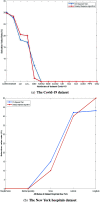Surveillance Routing of COVID-19 Infection Spread Using an Intelligent Infectious Diseases Algorithm
- PMID: 34812367
- PMCID: PMC8545257
- DOI: 10.1109/ACCESS.2020.3036347
Surveillance Routing of COVID-19 Infection Spread Using an Intelligent Infectious Diseases Algorithm
Abstract
In this study, the Intelligent Infectious Diseases Algorithm (IIDA) has been developed to locate the sources of infection and survival rate of coronavirus disease 2019 (COVID-19), in order to propose health care routes for population affected by COVID-19. The main goal of this computational algorithm is to reduce the spread of the virus and decrease the number of infected people. To do so, health care routes are generated according to the priority of certain population groups. The algorithm was applied to New York state data. Based on infection rates and reported deaths, hot spots were determined by applying the kernel density estimation (KDE) to the groups that have been previously obtained using a clustering algorithm together with the elbow method. For each cluster, the survival rate -the key information to prioritize medical care- was determined using the proportional hazards model. Finally, ant colony optimization (ACO) and the traveling salesman problem (TSP) optimization algorithms were applied to identify the optimal route to the closest hospital. The results obtained efficiently covered the points with the highest concentration of COVID-19 cases. In this way, its spread can be prevented and health resources optimized.
Keywords: Clustering; computational intelligence; coronavirus disease 2019 (COVID-19); kernel density estimation (KDE); medical care routing; optimization.
This work is licensed under a Creative Commons Attribution 4.0 License. For more information, see https://creativecommons.org/licenses/by/4.0/.
Figures









References
-
- Coronavirus Disease (COVID-19). Accessed: Oct. 29, 2020. [Online]. Available: https://www.who.int/emergencies/diseases/novel-coronavirus-2019
-
- Albarrak A. I., Mohammed R., Al Elayan A., Al Fawaz F., Al Masry M., Al Shammari M., and Miaygil S. B., “Middle east respiratory syndrome (MERS): Comparing the knowledge, attitude and practices of different health care workers,” J. Infection Public Health, to be published, doi: 10.1016/j.jiph.2019.06.029. - DOI - PMC - PubMed
-
- Zhang C., Du Z., Cai Q., Yu L., Li Z., and Bai Y., “Assignment optimization of pandemic influenza antiviral drugs in urban pharmacies,” J. Ambient Intell. Humanized Comput., vol. 10, no. 8, pp. 3067–3074, Aug. 2019.
LinkOut - more resources
Full Text Sources
Other Literature Sources
Miscellaneous
